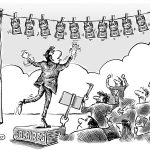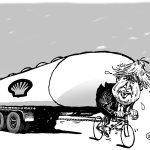Will there be inflation at Christmas?
Is inflation back for good? Markets are starting to worry about that.
The case is heard and widely expected, inflation is gaining ground. Whether on the side of Chinese producer prices (up 6.8% year-on-year in April), or us consumer prices (up 4.2% year-on-year, and even 3.0% excluding food and energy), the trend is on the rise and the markets are feeling1.
Let’s track the main reasons for these accelerations. Prices of agricultural, industrial and energy and raw materials jumped, recovering by 50% to 80% over the year. At the top of the list are the prices of copper, which alone illustrates the accelerated transformation of the auto sector to electricity. In the meantime, production constraints still weigh in the producing regions affected by the pandemic. As demand picks up, China, for its part, seems determined to reduce its CO2 emissions by limiting the production capacity of its heavy industries. Further downstream, bars and restaurants – to speak only of them – are back in service, and are running out of staff. Hence the U.S. job creation figures for April which were disappointing only on the surface. It is all about a lack of manpower and promises of wage increases. Away from the Congress’ rebuff, Joe Biden’s $15 minimum wage proposal is about to pass, from retail giants (Amazon in the lead) to smaller and medium-sized businesses.
The shock is temporary; the recovery dynamics is a healthy catch-up…
Increased final demand thanks to budgetary windfalls, restart of activity thanks to the vaccination progress, tensions on supply chains: the initial supply shock caused by the pandemic, masked by the collapse of demand last year, comes back in boomerang.
At this point, there is nothing fundamentally disturbing. In any case, this is what the central banks say and reiterate at each of their recent meetings: the shock is temporary, the recovery dynamics is a healthy catch-up, which will close the outgap opened last year.
So why worry about it? Of course, calls for monetary tightening are becoming more pressing. However, it seems that it is rather on the side of the gradual withdrawal of budgetary support that we must wait for the lull. The announced and promised stimulus packages, considered insufficient on the European side and overestimated on the American side, should not be able to sustain the fire of growth for long. Similarly, the economic transformation at work goes in hand with an acceleration of robotics and the hope of an increase in overall productivity, capable of absorbing the additional income distributed.
The surplus of cash confines to magic money, at the risk of destabilizing financial systems.
However, recent official statements and official commitments to reducing greenhouse gas emissions, redeploying value chains and local consumption, however desirable, are forcing an accelerated conversion of industries. The continued slowdown in labour force growth continues, including in China. Anxious not to repeat the “mistakes” of the post-2008 term, public debt is on the rise, while the surplus of free cash confines to magic money, at the risk of destabilizing financial systems.
The current economic situation, still marked by the difficulties due to the progress/retreat of the pandemic, from one region to another, does not allow definitive conclusions to be drawn as to the sustainable return of inflation. The basic effects will blur the overall picture and allow for divergent interpretations and as many market jolts.
Meanwhile, rising U.S. deficits are pushing the dollar down, long-term yields could start affecting peripheral markets, and sectoral rotations are accelerating.
Should we be afraid of what we have so longed for?
1 See our article of March 9, 2021: “The small rate that goes up…”
Valérie Plagnol – May2021 – Published in French in www.allnews.ch – Cartoon ©Barret



